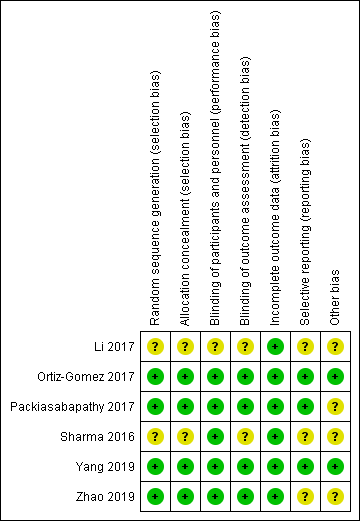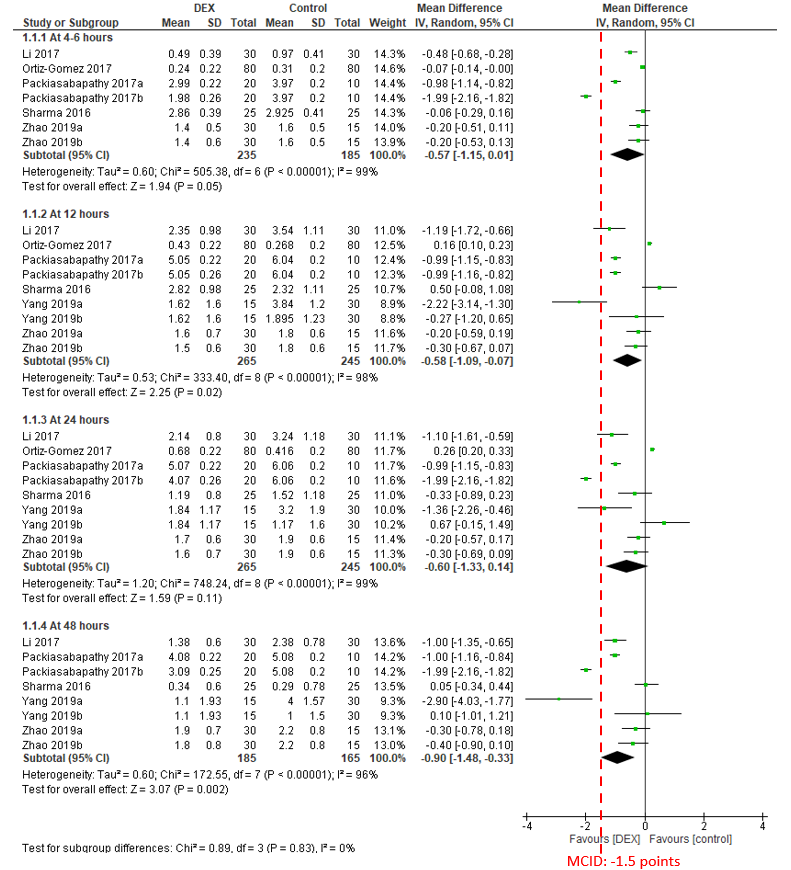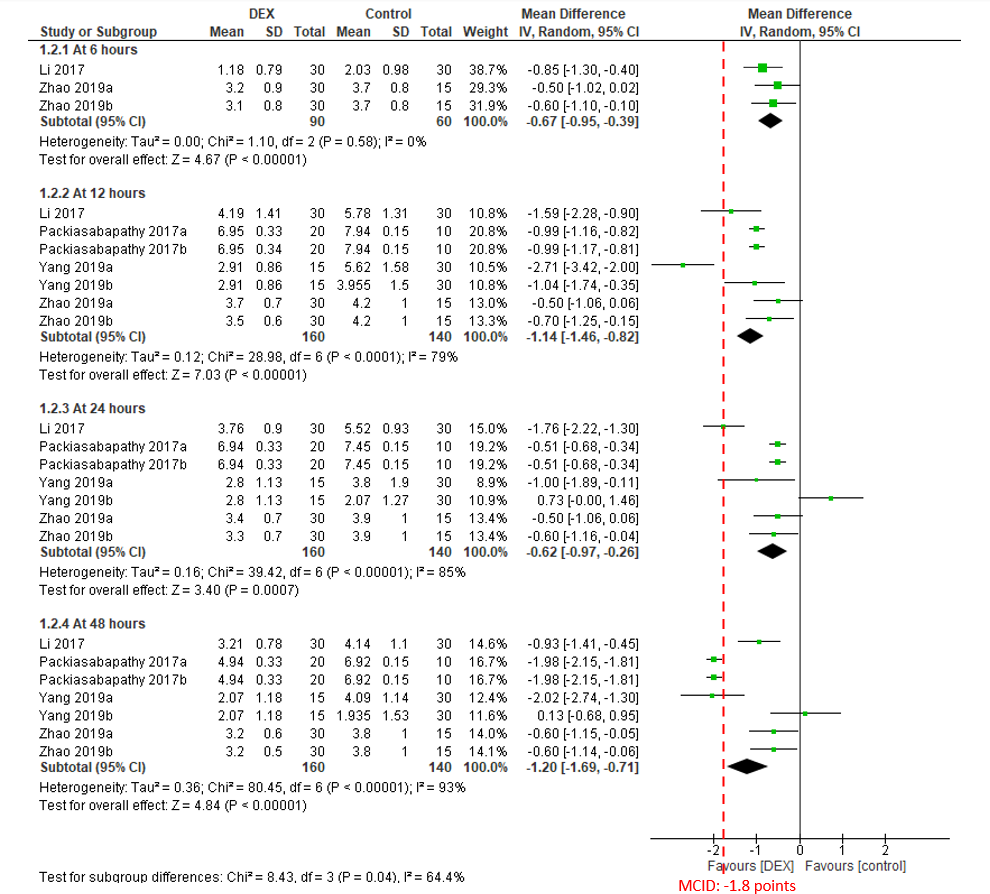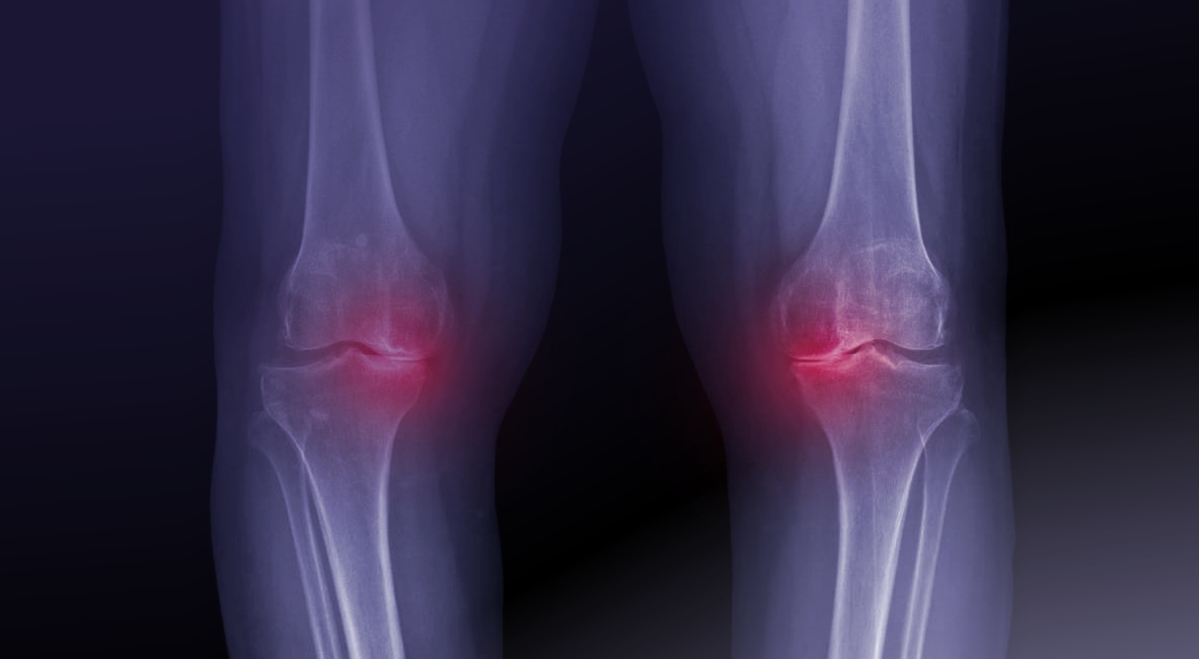Total knee arthroplasty (TKA) is a common and effective treatment for patients with end-stage knee osteoarthritis. There has been an increase in the rate of TKA worldwide. Over 170,000 primary TKAs (209 per 100,000 population) were performed in Germany in 2018 (Klug et al., 2021). Studies predict that the annual total number of primary TKAs will reach 1,429,000 in the United States by 2040 and approximately 226,000 (47,313 per 100,000 population) in Germany by 2050 (Singh et al., 2019; Klug et al., 2021). However, TKA is often accompanied with moderate or severe postoperative acute pain, which impacts patients’ recovery (Li et al., 2019).
Femoral nerve block (FNB), a regional anesthetic technique, has been commonly used as a postoperative pain treatment after TKA. FNB is considered as an effective and safe alternative to opioids, and can be administered with a single dose or as a continuous analgesia (Paul et al., 2010).
Dexmedetomidine is an alpha 2-adrenoceptor agonist and has been used as a sedative-analgesic agent in clinical practice for over two decades (Gertler et al., 2001). The properties of dexmedetomidine include sedation, analgesia, anxiolysis, sleep improvement, and anti-inflammatory effect (Jaakola et al., 1991; Zhao et al., 2020). Previous studies demonstrated the analgesic efficacy of dexmedetomidine as an adjuvant agent to local anesthetics in adductor canal block, epidural analgesia and FNB after TKA (Pan et al., 2020; Zhao et al., 2020).
In this OE Original, we conducted a systematic review of randomized controlled trials (RCTs) and examined up-to-date evidence in which dexmedetomidine was investigated as an adjuvant to FNB in patients undergoing TKA.
Methods
We searched Ovid MEDLINE, Ovid EMBASE, Cochrane Controlled Register of Trials (CENTRAL), and OrthoEvidence from database inception to September 20, 2022 with both indexed terms and free text terms regarding dexmedetomidine, and total knee replacement (or total knee arthroplasty). Reference lists and existing systematic reviews were also searched to identify additional eligible studies.
Studies were eligible for inclusion if they met the following criteria: RCTs that compared dexmedetomidine added to FNB with FNB alone for adult patients who underwent TKA, and that were published in English with full texts available. Conference abstracts were excluded.
We are presenting the meta-analysis results for pain at rest, pain during movement, amount of rescue analgesic agents, and safety outcomes at three follow-up timepoints: 4 to 6 hours, 12 hours, 24 hours, and 48 hours post-intervention. For dichotomous outcomes, we presented risk ratios (RRs) and 95% confidence intervals (CIs). For continuous outcomes, we presented the mean difference (MD) and 95% CI. For studies with outcomes for more than two eligible treatment or control arms — for example, if a study has one treatment arm and two control arms — we divided the data in the treatment arm by 2 in order to avoid double counting for studies with multiple arms (Higgins et al., 2022). We rated the quality of evidence by GRADE assessment and applied the recommended minimal clinically important difference (MCID) for the respective outcomes to assess the magnitude of effects.
Results
1. Characteristics of included studies
We identified 6 RCTs investigating the effectiveness of the added dexmedetomidine to FNB compared with FNB for postoperative pain management in patients who underwent TKA (Table 1). The majority of included studies were conducted in Asia (N=5, 83%), followed by Europe (N=1, 27%). One study received institutional funding (Ortiz-Gomez et al., 2017), two studies were supported by the government (Yang et al., 2019; Zhao et al., 2019), two studies received no financial support (Packiasabapathy et al., 2017; Sharma et al., 2016), and one study did not provide relevant information on funding (Li et al., 2017). One study enrolled more than 100 patients (Ortiz-Gomez et al., 2017). General anesthesia was used in 1 study (Li et al., 2017) and spinal anesthesia was used in 5 studies (Ortiz-Gomez et al., 2017; Packiasabapathy et al., 2017; Sharma et al., 2016; Yang et al., 2019; Zhao et al., 2019) for TKA surgery. The characteristics of the RCTs and the study arms included in meta-analysis are presented in Table 1. Details describing administration of dexmedetomidine and the FNB are presented in Table 2.
Table 1. Characteristics of randomized controlled trials (RCTs) included in meta-analysis
Study ID | Country | Funding Source | Sample Size* | Age (years)** | Sex (F/M) | Groups |
Li et al., 2017 | China | NR | 60 | 69.7 (5.96) | 31/40 | 1. Dexmedetomidine + Single-shot FNB 2. Single-shot FNB |
Ortiz-Gomez et al., 2017 | Spain | Hospital Complex of Navarra, University Hospital Puerta de Hierro Majadahonda | 660 | 70.7 (8.3) | 359/280 | 1. Dexmedetomidine + Single-shot FNB 2. Single-shot FNB and 6 additional groups (not eligible to be included in our meta-analysis) |
Packiasabapathy et al., 2017 | India | No financial support | 60 | 61.2 (10.3) | 39/21 | 1. Dexmedetomidine 1 µg/kg + Single-shot FNB 2. Dexmedetomidine 2 µg/kg + Single-shot FNB 3. Single-shot FNB |
Sharma et al., 2016 | India | No financial support | 50 | 65.2 (8.4) | 28/22 | 1. Dexmedetomidine + Continuous FNB 2. Normal saline + Continuous FNB |
Yang et al., 2019 | China | National Natural Science Foundation of China | 90 | 68.4 (2.9) | Unclear | 1. Dexmedetomidine + Continuous FNB (0.1% ropivacaine) 2. Continuous FNB (0.1% ropivacaine) 3. Continuous FNB (0.2% ropivacaine) |
Zhao et al., 2019 | China | Shanxi Provincial Youth Foundation Project | 90 | 71.7 (6.5) | 48/42 | 1. Dexmedetomidine 0.02 µg/kg/hour + Continuous FNB 2. Dexmedetomidine 0.05 µg/kg/hour + Continuous FNB 3. Continuous FNB |
* Number of participants at randomization; ** Age was presented as mean and standard deviation (SD) unless otherwise specified; NR, Not reported; FNB, femoral nerve block.
Table 2. Details of intervention and control of the included studies
Study ID | Intervention | Control | ||
Dexmedetomidine | FNB Protocol | Timing | ||
Li et al., 2017 | 1 µg/kg | Single dose of 20 mL (0.5%) ropivacaine | Administered preoperatively | Same as FNB protocol |
Ortiz-Gomez et al., 2017 | 100 µg | Single dose of 20 mL (0.375%) levobupivacaine | With spinal anesthesia | Same as FNB protocol |
Packiasabapathy et al., 2017 | 1) 1 µg/kg 2) 2 µg/kg | Single dose of 20 mL (0.25%) bupivacaine | With spinal anesthesia | Same as FNB protocol |
Sharma et al., 2016 | 1.5 µg/kg | Continuous FNB with 0.2% ropivacaine; infusion was commenced at 6 mL/hour. | At first complaint of pain or when spinal anesthesia segment receded to L1 | Normal saline and the same FNB protocol |
Yang et al., 2019 | 2 µg/kg | Continuous FNB of 0.1% ropivacaine with an infusion rate of 5 mL/hour | Started immediately after surgery | 1) Same as FNB protocol 2) Continuous FNB of 0.2% ropivacaine with an infusion rate of 5 mL/hour |
Zhao et al., 2019 | 1) 0.02 µg/kg/h 2) 0.05 µg/kg/h | Continuous FNB with 0.15% ropivacaine; infusion was commenced at 5 mL/hour; PCA dose was 10 mL, and locking time was 30 minutes. | Started at the end of TKA | Same as FNB protocol |
FNB, femoral nerve block; PCA, patient-controlled analgesia; TKA, total knee arthroplasty.
In terms of risk of bias (Figure 1), two RCTs did not provide adequate information in random sequence generation, allocation concealment, blinding of outcome assessment, and selective reporting (Li et al., 2017; Sharma et al., 2016). All the included RCTs had low risk of bias in incomplete outcome data.
Figure 1. Risk of bias assessment

2. Quantitative synthesis
All the included RCTs reported a 0 to 10 scale to assess patient self-reported pain using the visual analogue scale (VAS), the verbal rating scale (VRS), or the numeric rating scale (NRS). The MCID of pain score in patients after TKA is described and equivalent to 1.5 points at rest and 1.8 points duration movement on the 0 to 10 scale (Laigaard et al., 2021).
2.1 Pain score at rest (0 to 10, a higher score indicates worse pain)
In the current comparison of dexmedetomidine added to FNB versus FNB alone for pain at rest, 2 RCTs reported this outcome at 4 hours (Packiasabapathy et al., 2017; Sharma et al., 2016), and 3 RCTs reported this outcome at 6 hours of follow-up (Li et al., 2017; Ortiz-Gomez et al., 2017; Zhao et al., 2019). At 4 to 6 hours post-intervention, there was no significant difference between the two groups (420 patients from 5 RCTs; MD, -0.57; 95% CI, -1.15 to 0.01) with the upper boundary of the 95% CI having slightly crossed the no-effect threshold of 0. The certainty of evidence was rated as low due to imprecision and inconsistency (Figure 2).
At 12 hours of follow-up, a total of 510 patients from 6 RCTs published between 2016 and 2019 were included in the analysis. The overall effect shows that dexmedetomidine added to FNB results in a significant improvement in pain at rest with patients experiencing, on average, a 0.58 (95% CI, 0.07 to 1.09) point improvement. We rated down 1 level for the GRADE certainty of evidence because of serious risk of inconsistency. The point estimate of effect and 95% CI did not exceed the recommended MCID of 1.5 points on the 0 to 10 scale (Figure 2).
At 24 hours of follow-up, data from the same studies as those for the outcome at 12 hours were included in the analysis. There is no significant difference between the two groups (510 patients from 6 RCTs; MD, -0.6; 95% CI, -1.33 to 0.14), with low certainty of evidence (Figure 2).
At 48 hours of follow-up, a total of 350 patients from 5 RCTs were included in the analysis. The overall effect demonstrates that dexmedetomidine added to FNB results in a significant improvement in pain at rest with patients experiencing, on average, a 0.9 (95% CI, 0.33 to 1.48) point improvement, with moderate certainty of evidence. Nevertheless, the effect and 95% CI did not exceed the recommended MCID of 1.5 points on the 0 to 10 scale (Figure 2).
Figure 2. Forest plot of pain at rest on a 0-10 scale

DEX, dexmedetomidine; MCID, minimal clinically important difference.
2.2 Pain score during movement (0 to 10, a higher score indicates worse pain)
Two RCTs reported pain during movement at 6 hours of follow-up (Li et al., 2017; Zhao et al., 2019). The overall effect shows that dexmedetomidine added to FNB results in a significant improvement in pain during movement with patients experiencing, on average, a 0.67 (95% CI, 0.39 to 0.95) point improvement, with high certainty of evidence. The point estimate of effect and 95% CI did not exceed the recommended MCID of 1.8 points on the 0 to 10 scale (Figure 3).
At 12 hours of follow-up, a total of 300 patients from 4 RCTs published between 2017 and 2019 were included in the analysis. The overall effect shows that dexmedetomidine added to FNB results in a significant improvement in pain during movement with patients experiencing, on average, a 1.14 (95% CI, 0.82 to 1.46) point improvement, with moderate certainty of evidence due to serious risk of inconsistency (Figure 3).
At 24 hours and 48 hours of follow-up, data from the same studies as those for the outcome at 12 hours were included in the analyses (300 patients from 4 RCTs). The pooled result shows that dexmedetomidine added to FNB results in a significant improvement in pain during movement with patients experiencing, on average, a 0.62 (95% CI, 0.26 to 0.97) point improvement at 24 hours, and a 1.2 (95% CI, 0.71 to 1.69) point improvement at 48 hours, with moderate certainty of evidence (Figure 3).
The effects and 95% CIs at 12, 24, and 48 hours post-intervention did not exceed the recommended MCID of 1.8 points on the 0 to 10 scale (Figure 3).
Figure 3. Forest plot of pain during movement on a 0-10 scale

DEX, dexmedetomidine; MCID, minimal clinically important difference.
2.3 Rescue analgesia consumption (morphine, mg)
In total, 4 RCTs reported rescue analgesic consumption of morphine. One study reported this outcome at 24 hours (Ortiz-Gomez et al., 2017), and 3 RCTs reported this outcome at 48 hours of follow-up (Packiasabapathy et al., 2017; Sharma et al., 2016; Yang et al., 2019). The overall effect shows that compared to FNB alone, dexmedetomidine added to FNB results in significantly less consumption of morphine for pain control, on average, 3.52 mg (95% CI, 0.47 to 6.57 mg) less in amount, with moderate certainty of evidence (Figure 4).
Figure 4. Forest plot of rescue analgesic consumption of morphine (mg)

DEX, dexmedetomidine.
2.4 Incidence of adverse events
At the longest follow-up, a total of 350 patients from 5 RCTs published between 2016 and 2019 reported the outcome of adverse events (Figure 4). In 3 studies, patients did not report any adverse events in either group (Li et al., 2017; Sharma et al., 2016; Yang et al., 2019).
There is no significant difference between dexmedetomidine added to FNB and FNB alone for incidence of adverse events (350 patients from 5 RCTs; 5.4% in the intervention group vs. 3.6% in the control group; RR, 0.80; 95% CI, 0.28 to 2.26), with moderate certainty of evidence due to imprecision (Figure 4).
The reported adverse events included hypotension, bradycardia, and nausea/vomiting (Packiasabapathy et al., 2017; Zhao et al., 2019).
Figure 4. Forest plot of adverse events and serious adverse events

DEX, dexmedetomidine.
We present a summary of the four outcome measures at three follow-up timepoints in Table 3.
Table 3. Summary and certainty of the evidence
Outcome | Follow-up | |||
4-6 hours | 12 hours | 24 hours | 48 hours | |
Pain at rest | No difference (Low certainty) | Favours DEX (Moderate certainty) | No difference (Low certainty) | Favours DEX (Moderate certainty) |
Pain during movement | Favours DEX (High certainty) | Favours DEX (Moderate certainty) | Favours DEX (Moderate certainty) | Favours DEX (Moderate certainty) |
Rescue analgesic consumption of morphine* | Favours DEX (Moderate certainty) | |||
Any adverse events* | No difference (Moderate certainty) | |||
DEX, dexmedetomidine (as a combination of femoral nerve block); **At the longest follow-up, 24 or 48 hours post-intervention.
Discussion
In this OE Original, we identified 6 RCTs that investigated the efficacy and safety of addition of dexmedetomidine to the usual analgesic agents (bupivacaine, levobupivacaine or ropivacaine) for FNB versus FNB without dexmedetomidine in patients undergoing TKA. Our meta-analyses showed that the addition of dexmedetomidine was associated with small benefits in pain improvement at 12 and 48 hours’ follow-up for pain at rest, and at all the follow-up timepoints up to 48 hours for pain during movement, with moderate to high certainty of evidence. The effects and 95% CIs did not exceed the recommended MCID.
Compared to the usual FNB, the addition of dexmedetomidine results in significantly less consumption of postoperative rescue analgesia (MD, -3.52 mg; 95% CI, -6.57 to -0.47 mg of morphine), with moderate certainty of evidence.
There were no statistically significant differences in adverse events (hypotension, bradycardia, nausea or vomiting) between the intervention and control groups at the longest follow-up (24 or 48 hours post-intervention, P value=0.51).
The results in this OE Original are consistent with the previously published systematic reviews that have found dexmedetomidine as a perineural adjuvant to local anesthetics for FNB following TKA improves pain, decreases opioid consumption, and prolonged analgesic duration without increasing adverse events (Pan et al., 2020; Zhao et al., 2020). Our analyses further compared the pooled results with the MCIDs to provide a comprehensive profile in assisting clinical decision making.
One of the major concerns during the evidence quality assessment was inconsistency. We rated down one level of GRADE quality of assessment for inconsistency for outcomes when the values of I2 were greater than 40% (Guyatt et al., 2011). In this OE Original, outcomes of pain during movement at 6 hours of follow-up and incidence of adverse events showed good consistency (I2=0%) across the included studies, and we did not rate down the level of GRADE for this domain. The diversity in patient conditions (studies enrolled a mixture or sole types of patients), doses (from a single dose to 5 doses) and types of HA prevented us from performing appropriate subgroup analyses. We take into account the identified heterogeneities across studies by lowering the GRADE rating by one level for pain at 1 and 3 months’ follow-up, function at 3 and 6 months’ follow-up, and incidence of serious adverse events (Guyatt et al., 2011b). We conducted a sensitivity analysis by excluding outcome data of the third group with a higher concentration/dose of ropivacaine for FNB in one RCT [Yang et al., Group 1. dexmedetomidine + continuous FNB (0.1% ropivacaine), Group 2. continuous FNB (0.1% ropivacaine, and Group 3. Continuous FNB (0.2% ropivacaine)]. The finding of the sensitivity analysis did not impact our results or heterogeneities across the studies (I2>40% for pain at rest or during movement at most of the follow-up timepoints).
Additional future research with larger sample sizes, and investigating different doses of dexmedetomidine as an adjuvant to the usual FNB is needed to comprehensively evaluate the outcomes and associated cost, and verify the findings of the current meta-analysis results.
Bottom Line
A meta-analysis of 6 RCTs showed that for patients undergoing TKA, the addition of dexmedetomidine to the usual analgesic agents used for FNB is associated with small benefits in pain at rest at 12 and 24 hours, and in pain during movement at 6, 12, 24 and 48 hours post-intervention. The consumption of postoperative rescue analgesia of morphine is significantly lower in patients who received the addition of dexmedetomidine to FNB than those who received the usual FNB. There was no statistically significant difference in the incidence of adverse events between the intervention and control groups
References
Gertler R, Brown HC, Mitchell DH, Silvius EN. Dexmedetomidine: a novel sedative-analgesic agent. InBaylor University Medical Center Proceedings 2001 Jan 1 (Vol. 14, No. 1, pp. 13-21). Taylor & Francis.
Guyatt GH, Oxman AD, Kunz R, Woodcock J, Brozek J, Helfand M, Alonso-Coello P, Glasziou P, Jaeschke R, Akl EA, Norris S. GRADE guidelines: 7. Rating the quality of evidence—inconsistency. Journal of clinical epidemiology. 2011 Dec 1;64(12):1294-302.
Higgins JPT, Thomas J, Chandler J, Cumpston M, Li T, Page MJ, Welch VA (editors). Cochrane Handbook for Systematic Reviews of Interventions version 6.3 (updated February 2022). Cochrane, 2022. Available from www.training.cochrane.org/handbook.
Jaakola ML, Salonen M, Lehtinen R, Scheinin H. The analgesic action of dexmedetomidine—a novel a2-adrenoceptor agonist—in healthy volunteers. Pain. 1991 Sep 1;46(3):281-5.
Klug A, Gramlich Y, Rudert M, Drees P, Hoffmann R, Weißenberger M, Kutzner KP. The projected volume of primary and revision total knee arthroplasty will place an immense burden on future health care systems over the next 30 years. Knee Surgery, Sports Traumatology, Arthroscopy. 2021 Oct;29(10):3287-98.
Laigaard J, Pedersen C, Rønsbo TN, Mathiesen O, Karlsen AP. Minimal clinically important differences in randomised clinical trials on pain management after total hip and knee arthroplasty: a systematic review. British Journal of Anaesthesia. 2021 May 1;126(5):1029-37.
Li J, Wang H, Dong B, Ma J, Wu X. Adding dexmedetomidine to ropivacaine for femoral nerve block inhibits local inflammatory response. Minerva anestesiologica. 2017 Jan 20;83(6):590-7.
Li JW, Ma YS, Xiao LK. Postoperative pain management in total knee arthroplasty. Orthopaedic surgery. 2019 Oct;11(5):755-61.
Ortiz-Gómez JR, Perepérez-Candel M, Vázquez-Torres JM, Rodriguez-Del Río JM, Torrón-Abad B, Fornet-Ruiz I, Palacio-Abizanda FJ. Postoperative analgesia for elective total knee arthroplasty under subarachnoid anesthesia with opioids: comparison between epidural, femoral block and adductor canal block techniques (with and without perineural adjuvants). A prospective, randomized, clinical trial. Minerva Anestesiol. 2017 Jan;83(1):50-58.
Packiasabapathy SK, Kashyap L, Arora MK, Batra RK, Mohan VK, Prasad G, Yadav CS. Effect of dexmedetomidine as an adjuvant to bupivacaine in femoral nerve block for perioperative analgesia in patients undergoing total knee replacement arthroplasty: a dose–response study. Saudi journal of anaesthesia. 2017 Jul;11(3):293.
Pan L, Wu H, Liu H, Yang X, Meng Z, Cao Y. Dexmedetomidine as an adjunct to local anesthetics in nerve block relieved pain more effectively after TKA: a meta-analysis of randomized controlled trials. Journal of Orthopaedic Surgery and Research. 2020 Dec;15(1):1-0.
Paul JE, Arya A, Hurlburt L, Cheng J, Thabane L, Tidy A, Murthy Y. Femoral nerve block improves analgesia outcomes after total knee arthroplasty: a meta-analysis of randomized controlled trials. The Journal of the American Society of Anesthesiologists. 2010 Nov 1;113(5):1144-62.
Sharma B, Rupal S, Swami AC, Lata S. Effect of addition of dexmedetomidine to ropivacaine 0.2% for femoral nerve block in patients undergoing unilateral total knee replacement: A randomised double-blind study. Indian journal of anaesthesia. 2016 Jun;60(6):403.
Singh JA, Yu S, Chen L, Cleveland JD. Rates of total joint replacement in the United States: future projections to 2020–2040 using the national inpatient sample. The Journal of rheumatology. 2019 Sep 1;46(9):1134-40.
Yang X, Kang W, Xiong W, Lu D, Zhou Z, Chen X, Zhou X, Feng X. The effect of dexmedetomidine as adjuvant to ropivacaine 0.1% for femoral nerve block on strength of quadriceps muscle in patients undergoing total knee arthroplasty: a double-blinded randomized controlled trial. Journal of pain research. 2019;12:3355.
Zhao XY, Zhang EF, Bai XL, Cheng ZJ, Jia PY, Li YN, Guo Z, Yang JX. Ultrasound-guided continuous femoral nerve block with dexmedetomidine combined with low concentrations of ropivacaine for postoperative analgesia in elderly knee arthroplasty. Medical Principles and Practice. 2019;28(5):457-62.
Zhao ZF, Du L, Wang DX. Effects of dexmedetomidine as a perineural adjuvant for femoral nerve block: A systematic review and meta-analysis. PloS one. 2020 Oct 19;15(10):e0240561.




 LOGIN
LOGIN


Join the Conversation
Please Login or Join to leave comments.